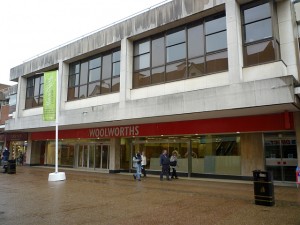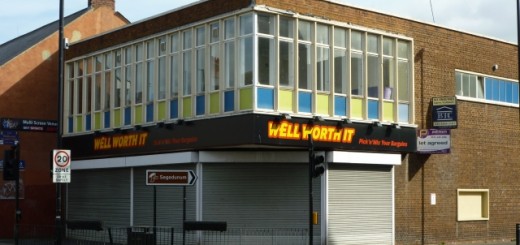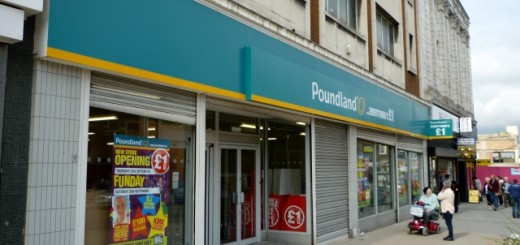Visiting Sutton Coldfield’s former Woolies – one of 300 still empty across the UK
On Monday – the day that The Local Data Company published new figures on the number of vacant Woolies sites remaining across the UK – I paid a visit to Sutton Coldfield, in the West Midlands, and one of those still-empty shops.
I remember visiting the Sutton Coldfield Woolworths as a child, and it was always a very large store, spread over two floors. Unusually, there were also entrances on two sides: one on The Parade, and another opening onto what used to be known as the Gracechurch Shopping Centre – today’s The Mall Sutton Coldfield, and before that The Mall Gracechurch.
I don’t know which retailer is being lined up to occupy the site, but there were some people inside when I walked by, and possible signs of preparatory works. The Mall Sutton Coldfield’s own floor plan also shows the unit as ‘under offer’[broken link removed].
The size of the store is perhaps the reason why it’s remained empty until now, given that there are few retailers not already represented in Sutton Coldfield who could use such a large space – Primark or TJ Hughes being obvious contenders.
Though The Local Data Company’s research suggests that 300 of the 807 old Woolies sites are still vacant, such calculations are never an exact science. For one thing, the situation is still changing on a day-to-day basis, as the impending occupation of the Sutton Coldfield Woolies unit demonstrates.
The research also highlights some regional breakdowns, suggesting that in the North East, 55% of former Woolies units have been taken over – in other words, 18 of the 33 stores. By my reckoning, however, the real figure is 23 – a healthier percentage of almost 70%.
The results do vary though, depending on the assessment criteria that are used. If you include those old Woolies stores that have had an occupant but are now empty again – in Middlesbrough (Waremart) and Wallsend (Well Worth It) – the figure increases to 25 out of 33, or 75%.
However, take away the five former Woolies sites where only a proportion of the floorspace has been reoccupied – at Ashington, Consett, Jarrow, Portrack Lane and South Shields – and you do end up with the finding that only 18 of the 33 North East locations have been fully reoccupied.
By whichever measure, I’m inclined to think that The Local Data Company’s figures underestimate the true take-up of old Woolies sites in the North East. Equally, I’m not entirely convinced by the research’s conclusion that 150 Woolworths stores nationwide – or nearly 20% of the entire estate – may never be used for retail again.
It’s true that some of the empty North East sites – like Gateshead, Newcastle, Newton Aycliffe and Peterlee – are poorly maintained buildings in iffy locations that were never likely to be at the top of retailers’ wishlists.
Other locations in the region, however, have found new occupants more readily than might have been expected, while some of the most modern and well-located sites – among them MetroCentre, Middlesbrough and Hartlepool – must surely attract new tenants before long.
Recent lettings to The Range at Portrack Lane and Store Twenty One in Jarrow, as well as Asda’s ongoing plans for the old Byker store, show that retailers’ interest in former Woolies sites hasn’t dried up yet. Perhaps we should therefore wait a little longer before declaring that some old Woolies premises are an entirely lost cause.
UPDATE, 3 September 2010: The Sutton Coldfield Observer has reported today that H&M is taking over most of the former Woolies site, moving from its existing smaller site nearby.











1 Response
[…] I blogged about the remaining vacant Woolies stores in the North East a few days ago, I’d failed to spot that yet another is about to be reoccupied, with Boyes […]